From The CRPG Addict
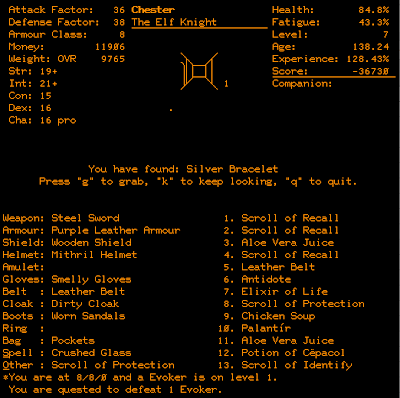 |
My inventory fills up as I continue with Camelot.
|
Since my first year of blogging, when I forced myself to win Wizardry while adhering to its implementation of permadeath, I’ve often remarked that I would never do that again. My adherence to “playing the way the developers intended” was so strict that during the remainder of the year, I quit Wizardry II, III, and IV rather than even consider backing up the save files. (I would later return to II and III and win both under more relaxed rules.) These days, I am likely to try to abide by both the developer’s original intent and my own “conduct” (limited saves), but I feel that showing and documenting the endgame are more important than questions of integrity.
Thus, there’s a certain exhilaration to the occasional PLATO game, where cheating isn’t even an option. (At least, not in most forms, though see below for a slightly unusual version.) When my character dies, I frequently have a moment of disbelief, almost like people who experience sudden tragedies report having in real life. A couple years ago, I happened to speak to a woman whose husband had fallen asleep while driving home from work and had run head-on into a truck. “I remember thinking he was just here,” she told me. “How could such a simple mistake be so irrevocable? How could there be no rewind button? No do-over?” That’s how I feel when my elf fighter gets killed by a demon. I mean, maybe not exactly, but there are analogues.
The point is, life is precious in the real world and in Camelot, so it becomes all that more meaningful when you succeed. And while death may be a constant danger in the game, it’s not at all arbitrary. When it happens to me, it’s almost always because I’ve bitten off more than I can chew. The game is actually quite good about offering multiple ways out of a situation, about not requiring you to engage enemies that you don’t want to engage. You have to be quick with your fingers, but it would be theoretically possible to explore an entire dungeon level, and collect a good percentage of its treasure, without engaging in a single combat round.
The problem is that once you decide to stand and fight, the game can be relentless. For instance, last night I wandered into a room and faced “6 imps.” I had faced imps before. They’re a demon type, but not very hard, and I was a relatively high level. Generally, when facing stacks of multiple enemies, you concentrate on killing one. Once you do, you escape the room, pray for healing, re-enter, and try to kill the next one. If you must, you can return to the town if your prayers run out.
What I didn’t know was that the 6 creatures weren’t actually imps; they were
manes. That’s a tougher demon. It turns out that this game goes one better than
Oubliette, which often gave you the category of monster but not the specific monster. In
Camelot, the character can
mis-identify the specific monster. When I hit (F)ight, I watched myself do 60% damage to one creature and then watched as the demons took their turn and pounded my health from 100% to 40% in one round. There’s no way to escape or to do anything in the middle of a combat round; that’s the point of no return. At that point, I should have immediately fled, or prayed in combat, or done anything but attack a second time, because clearly the enemies were capable of doing more than 50% damage in a single round, and I was now below 50%. But some primitive part of my mind, trained on other RPGs, forgetting temporarily that actions are irrevocable, decided that I didn’t want to waste the 60% damage I’d already achieved, and to at least try to kill one of the demons before I escaped. I hit (F)ight again, missed, and was swiftly torn apart.
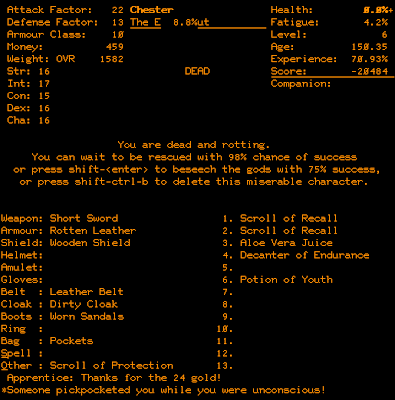 |
| Another death. |
As I mentioned last time, there’s a good chance of resurrection, and Chester was resurrected. He’s been resurrected a few times now. But each one comes with a loss of score, the higher the level the higher the loss, and Chester now has a score of over -99,999. Fortunately, it caps there. Joshua Tabin (the author) insists that I’ll recover those points at higher levels, but I’m not sure he’s considering the possibility that I’ll die a few more times at those higher levels, too.
I guess Joshua felt a little bad about the game’s difficulty as I reported it in the first entry (though, as he points out, it’s only difficult if you approach it as a typical RPG instead of as
Camelot specifically). Joshua and his Level 17 ogre, Drek McFeffer, joined me for a while last night on the first two levels. He ran ahead of me in the dungeon, decimating some of the rooms and alerting me where I could find lucrative treasure caches. One room on each dungeon level is designated the “stud room” and features better treasure and harder monsters than anywhere else on the same level. He helped me clear Level 1’s stud room a couple of times so I could bulk up my equipment. He also used his admin powers to insert a couple of useful items into the town’s store, and all the while he kept a steady stream of hints and tips going with the game’s chat feature. I still died twice, lest you think he made it too easy.
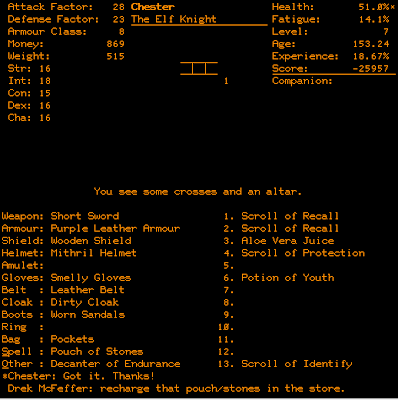 |
| The author throws me some hints as I map the dungeon. |
I can’t speak for the mid-game or late-game, but finding useful equipment in the early game is a joy. You have numerous equipment slots, and almost anything you find during the first 10 hours is an upgrade. I was more than three hours into the game before I even had a weapon, so finding my first short sword and then a steel sword was like hitting the real-life lottery. When I found a mithril helmet in one of the stud rooms, I had to stop myself from calling my mother with the good news. Later, it was destroyed because of a cursed item, and the pain was palpable.
Camelot does some clever things with its inventory, too. There are useful items like Palantirs, which tell you where you can find quest enemies (those you have to kill to level up), and Scrolls of Recall to whisk you back to town. The Scroll of Identify does what it suggests, but it can also be used to identify traps before you open chests, and items before you pick them up. The latter use is particularly important because some items are cursed, and in this game, cursed items break the items of the same type that you already have before replacing them. It’s a particular joy to find manuals, which increase your attributes permanently, but potions that increase them temporarily (they last a long time) are almost as good.
There are several items that let you briefly charm a monster companion. The Orb of Entrapment, for instance, seems to work on dragon types. Having one of those at your side really helps clear out a room.
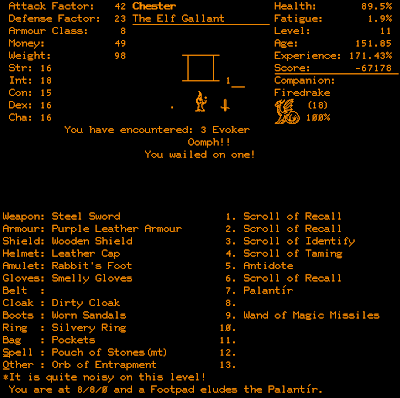 |
| A charmed firedrake follows me around. |
I also like how character development is palpable. At some point, you get two attacks per round, which makes you feel like Hercules on the first level. (Although, as I learned more than once, you still can’t get cocky.) Attack and defense factors increase as you level, and it’s rewarding to go from missing 90% of the time to 70% of the time, to reversing the ratio and hitting more times than you miss.
Joshua clarified a few things from the comments on the first entry. He absolutely intended the game to be played by a single player. However, he also expected that the player would use two simultaneous logins. He built a feature where one user can “follow” another user on an automap, and I guess it was common at the time for one player to take over two terminals with two user names, playing on one, and using the automap on the other. A single player with two characters can also have them rescue and resurrect each other, at a higher chance of success than if you rely on the whims of the gods. Thus, I applied for and received a second Cyber1 account.
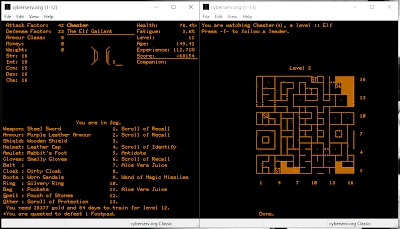 |
| Playing with two terminal windows side-by-side. |
I spent a number of hours mapping Level 2 and parts of Levels 3 and 4, but every time I thought I was finally badass enough to march around a level unopposed, I’d get my ass handed to me by some group of mages or demons who kill me in a single round.
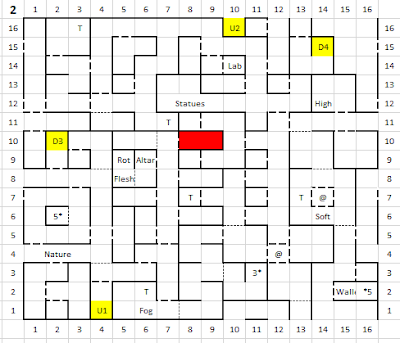 |
Level 2 of the Camelot dungeon.
|
In the first entry, I noted that a number of rooms have “flavor text,” and I noticed that various rooms on Level 2 repeated those on the first level. For instance, both have rooms coated in guano, filled with statues, with soft ground, with an empty wallet, and so forth. Both have a small room with beakers and burners that seems to be a lab. Both have a room where I feel a “force of nature.” Joshua has hinted at deeper puzzles later in the game, and I wonder if they have something to do with these rooms.
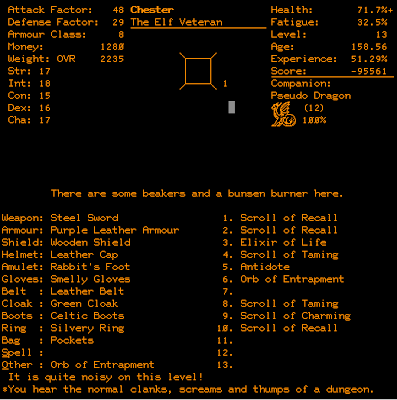 |
| If I need an alchemist’s lab later, I’ll know where to come. |
Camelot is probably going to have to go on the back burner for a while. I enjoy the gameplay, but it’s taken me 16 hours to build a Level 14 character and map two and a half levels. The characters who have actually won the game are Level 60. I’ll dip into it now and then as I continue to progress with the rest of my list.
Time so far: 16 hours
Original URL: http://crpgaddict.blogspot.com/2019/11/camelot-i-know-it-sounds-bit-bizarre.html







